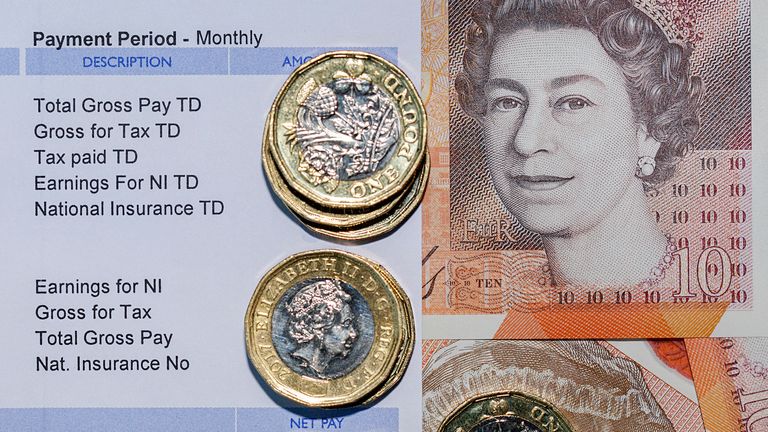Real wages see record plunge as public sector workers worst affected
Pay rises are failing to keep up with inflation - with total pay increases of 7.2% in the private sector and 1.5% in the public sector.
Tuesday 19 July 2022 10:17, UK
Regular pay has seen the biggest plunge in more than 20 years when rising prices are taken into account, according to the Office for National Statistics.
Real wages, excluding bonuses, fell an average of 3.7% over the three months to May, representing the worst annual drop since records began in 2001.
"Following recent increases in inflation, pay is now clearly falling in real terms both including and excluding bonuses," said David Freeman, head of labour market and household statistics for the ONS.
Inflation hit a new 40-year high of 9.1% in May and is expected to reach 11% in the autumn.
Real wages took a 3.9% hit in the year to May - an improvement on April's figure of 4.5%, but still worse than any other time on record.
When inflation was not factored in, regular pay - without bonuses - went up by 4.3% over the three months to May.
With bonuses, total pay jumped 6.2%, largely driven by sums given out in the financial sector.
The discrepancy was substantial between the public and private sectors.
Public sector workers, many of whom have been voting to strike over below-inflation pay offers, saw their total pay go up just 1.5% - compared with 7.2% in the private sector.
Pay increases in the public sector, both with and without bonuses, were at their lowest level since 2017. Base salaries went up just 1.8%.
In the private sector, regular pay without bonuses saw its biggest rise since the three months to last September - but falling bonuses saw total pay drop in recent months.
Pat McFadden, Labour's shadow chief secretary to the Treasury, said: "Today's record fall in real wages comes after a decade where wages have stagnated for workers across the economy.
"This is because the Conservatives have failed to grow the economy, which has left people more exposed to inflation and the cost-of-living crisis."
Unemployment drops
The employment rate remains below pre-pandemic levels despite increasing by 0.4 percentage points to 75.9%.
The number of UK workers on payrolls now stands at 29.6m, an increase of 31,000 from May to June.
While the number of people neither working nor looking for a job is now falling, it remains well up on where it was before COVID-19 hit.
Read more:
Thousands of nurses, teachers and doctors to find out what pay rises they will receive
How much are public sector workers paid - and how do recent pay deals compare to what train staff want?
"With demand for labour clearly still very high, unemployment fell again, employment rose and there was another record low for redundancies," Mr Freeman said.
Unemployment dropped to 3.8% over the three months to May, while the number of job vacancies rose by 6,900 to 1,294,000.
Follow the Daily podcast on Apple Podcasts, Google Podcasts, Spotify, Spreaker
Chancellor Nadhim Zahawi said: "Today's figures underline how strong our jobs market continues to be, providing encouragement in uncertain economic times - as we know being in work is one of the best ways for people to get on and support their families.
"I am acutely aware that rising prices are affecting how far people's hard-earned income goes, so we are providing help for households through cash grants and tax cuts.
"We're working alongside the Bank of England to bear down on inflation, providing support worth £37bn this financial year for the cost of living, and investing in skills to help people get into work and progress."



